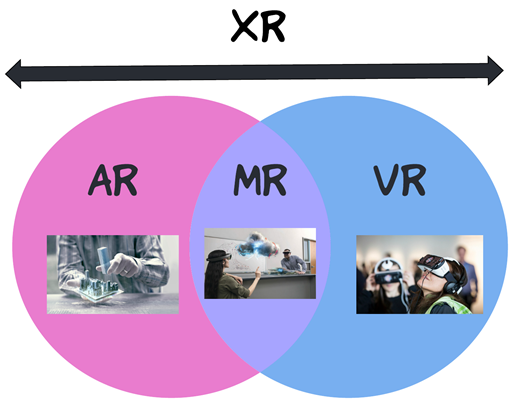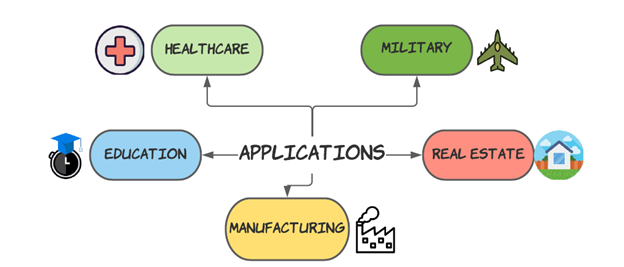The Metaverse [1] is a virtual shared area that is open to everyone. It is a catch-all term that refers to the entire digital and virtual world. Several initiatives are now developing digital twins of the physical world we live in and access this digital world through the network. To understand the individual components and technologies being used to develop Metaverse, let’s know more about virtual, augmented, mixed, and extended reality.

Figure 1: Relation between AR, VR, MR, and XRVirtual Reality (VR) is a technology that substitutes one’s vision of the physical world with a digitally produced scene using software and headgear devices [2]. While wearing full-coverage headsets, you are entirely cut off from your surroundings and the actual world. A computer-generated virtual environment is reflected by the LCD screens inside the lenses of these headset devices, and your viewpoint is replaced. The gadgets are usually connected to a PC or smartphone that displays virtual images. These images can be exact duplicates of real-world locations or locations from a totally fictional universe.
Augmented Reality (AR) is a technology that blends the digital and real worlds. It uses computer vision to recognize real-world surfaces and objects using technologies such as object recognition, plane detection, facial recognition, and movement tracking, among others. The computer then overlays computer-generated data like graphics, sounds, images, and messages on these previously recognized planes. AR improves the interaction between digital goods while also allowing us to observe our real-world surroundings in this way.
Mixed Reality (MR) is a hybrid of augmented reality and virtual reality as shown in Figure 1. It’s also known as Hybrid Reality since it incorporates both real-world and digital aspects. While MR is primarily a technology for combining the physical and virtual worlds, the most appealing technology is the lifelike interaction between users and digital items.
Extended reality (XR) is a new collective term encompassing all immersive technology as shown in Figure 1. We already have augmented reality (AR), virtual reality (VR), and mixed reality (MR), as well as that, will be developed in the future. Immersive technology either merges the virtual and “real” worlds or creates a totally immersive experience, extending our perception of reality. More than 60% of respondents predict XR will become mainstream in the next five years as it will be a major component of the metaverse environment. These are all promising technologies that will eventually propel Metaverse to new heights. Whether they combine their abilities or just excel in one, it is unavoidable that we adopt them in our work settings and daily lives.
Metaverse Applications
The advancement of extended reality in the Metaverse shared space may offer many things to offer to advance technology for society’s betterment. Other than social networks and entertainment, some of the applications already being used are:

Figure 2: Potential Applications of MetaverseMetaverse Healthcare applications
The deployment of augmented reality in the healthcare sector has a substantial value in training and strengthening the skills and knowledge base of future medical professionals. Surgical assistive tools are technology like the Microsoft Hololens that surgeons utilize to help them with and speed surgical procedures [4]. In addition to pre-operative pictures from CT, MRI, and 3D scans, AR headsets are used to view crucial real-time patient data such as heart rate, body temperature, blood pressure, and respiration rate.
Nurses and physicians are now using augmented reality to enhance vein identification [5]. This tackles the problem that locating a vein can be difficult for many individuals, amazingly if their skin is intensely pigmented or tiny blood veins. In the healthcare industry, visual-driven technology like X-rays and CT scans are prevalent. Simply put, they aid medical practitioners in detecting, diagnosing, and treating patients by allowing them to look within their patients’ bodies.
Metaverse Military Applications
Military applications of AR and VR have seen considerable breakthroughs as well. Tactical Augmented Reality (TAR) is a technology that appears similar to night-vision goggles (NVG), but it has many more capabilities. It may display a soldier’s precise location as well as the positions of ally and hostile forces. The system is attached to the helmet in the same manner that the goggles are, and it may be used at any time of day or night. As a result, TAR effectively substitutes the standard handheld GPS gadget and eyewear.
As a consequence, a soldier would no longer need to glance down to verify their GPS location. Furthermore, Synthetic Training Environment is an augmented reality system designed to provide soldiers a more realistic training experience by putting them in more physically and psychologically demanding combat settings. One of the key objectives of the STE creators is to create a training alternative that will enable commanders to produce adaptive units with a higher degree of preparation.
Metaverse Real estate applications
The capacity to give potential clients a realistic and immersive experience is VR’s greatest strength. Real estate marketers may take advantage of this power by allowing clients to ultimately see the property before making a choice. Several multimedia features, such as ambient music, narration, and light-and-sound effects, can also be included in specific VR tours. These aspects provide the encounter a feeling of reality and awe and boost clients’ confidence before they sign on the dotted line. Clients may explore the property and the surrounding area in real-time via virtual reality tours and guided walkthroughs. This reassures consumers about various decision variables, such as road conditions or the place’s ambiance, while also reducing the journey time to zero. Real estate agents also save time and money by avoiding costly showings and face-to-face meetings. Unlike conventional tours, virtual reality walkthroughs may be easily modified to appeal to various consumer tastes. The lighting, interior design, and zoom functions, for example, are helpful for highly visual clientele. Pop-up windows may be customized to present comprehensive information, statistics, and space measurements for more practical clients.
Metaverse Manufacturing applications
Accidents are substantially less likely if the maker uses virtual reality technology. People learn significantly faster and retain more when they study in a real-world setting. The manufacturer does not have to spend money or time educating a new employee because VR training takes care of it. Employees can also learn about safety precautions and even participate in a risky circumstance simulation. As a result, the likelihood of an accident is minimized. These technologies also aid in the development of better products. Each and every element of the product may be examined by just donning a VR goggle. Furthermore, manufacturers may simply create flooring using virtual reality. They can quickly choose the best location to put up the equipment and maintain the required space between them. It assists in the improvement of safety and the better planning of equipment locations. Ford personnel are utilizing virtual reality technology to access their locked-down models at a time when the coronavirus has spread worldwide. They’re making the most of virtual reality
Metaverse Education applications
Virtual reality is fantastic because it allows us to explore other worlds and experiences. Wearing a VR headset exposes you to high-quality representations that can positively impact your life. Traditional teaching approaches will never attain such a high level of effectiveness in highlighting concepts through visuals. Regardless of their age, students will always choose to sit and watch something rather than read it. Virtual reality technology is fascinating because it can produce incredible experiences that could never be “experienced” in real life. With the usage of this technology, students will be more motivated to learn.
Teachers nowadays find it extremely difficult to develop an effective classroom environment. With the advent of virtual reality technology in school, this feature will go permanently since most students would be enticed to talk about their virtual reality experiences [3]. Virtual reality may frequently assist in the detection of errors in content as well as give excellent editing capabilities. It also removes the barrier of language. When it comes to schooling, the language barrier is frequently a significant issue. If you wish to study in another nation, you must be able to communicate in that language. Virtual reality allows for the incorporation of any language into the software.
Current development towards Metaverse [6-8]
Meta (formerly Facebook) is considering opening retail stores to sell virtual reality, augmented reality, and other digital connection tools. Meta will require to get more of these tools into more homes to manage users toward Meta’s conception of the Metaverse, an immersive digital world of infinite possibilities, and physical stores may be a better way to build direct-to-consumer supply chains while also facilitating new showcase opportunities to produce more sales. In this regard, Meta’s VR headsets seem to be the most apparent emphasis. The company’s fully-enabled Metaverse vision-oriented around fully interactive VR worlds would only be genuinely achievable in a VR environment. That will very certainly need the formation of an independent consortium or industry-wide agreement, which would then promote the development of universal schemas and data exchange methods for interoperability inside the area and more innovative and collaborative routes. However, Meta is already leading the way in VR and appears to be well-positioned to win this change.
References:
- Jaynes, Christopher, et al. “The Metaverse: a networked collection of inexpensive, self-configuring, immersive environments.” Proceedings of the workshop on Virtual environments 2003. 2003.
- Zheng, J. M., K. W. Chan, and Ian Gibson. “Virtual reality.” Ieee Potentials 17.2 (1998): 20-23.
- Billinghurst, Mark. “Augmented reality in education.” New horizons for learning 12.5 (2002): 1-5.
- Andrews, Christopher, et al. “Extended reality in medical practice.” Current treatment options in cardiovascular medicine 21.4 (2019): 1-12.
- Ai, Danni, et al. “Augmented reality based real-time subcutaneous vein imaging system.” Biomedical optics express 7.7 (2016): 2565-2585.
- Mavneet Kaur, B. Gupta (2021) Metaverse: The Future of Internet and Cyber-world, Insights2techinfo, pp.1
- A. Khan, K. T. Chui, D. Peraković (2021) Future Scope of AI and Machine Learning in 2022, Insights2Techinfo, pp.1
- Nevelsteen, K. J. (2018). Virtual world, defined from a technological perspective and applied to video games, mixed reality, and the Metaverse. Computer Animation and Virtual Worlds, 29(1), e1752.
Cite this article
Mavneet Kaur, B. Gupta(2021) Metaverse Technologies and their Applications, Insights2Techinfo, pp.1
FAQ on Metaverse
The Metaverse is a virtual shared area that is open to everyone. It is a catch-all term that refers to the entire digital and virtual world.
There are many applications of Metaverse:
● Healthcare
● Military
● Real estate
● Manufacturing
● Education
Meta (formerly Facebook) is considering opening retail stores to sell virtual reality, augmented reality, and other digital connection tools. Meta will require to get more of these tools into more homes to manage users toward Meta’s conception of the Metaverse.
Virtual Reality (VR) is a technology that substitutes one’s vision of the physical world with a digitally produced scene using software and headgear devices
Augmented Reality (AR) is a technology that blends the digital and real worlds. It uses computer vision to recognize real-world surfaces and objects using technologies such as object recognition, plane detection, facial recognition, and movement tracking, among others.
Mixed Reality (MR) is a hybrid of augmented reality and virtual reality. It’s also known as Hybrid Reality since it incorporates both real-world and digital aspects.
Really Good Informative Research Blog Sir
Thank you for your support
Your style is so unique compared to other folks I’ve read stuff from. Thank you for posting when you have the opportunity, Guess I’ll just bookmark this blog.
This blog is a vital resource for people to become familiar with Virtual Reality Augmented. I am expecting a turnaround strategy that involves use of VR that will completely change the educational experiences and mature into something positive.